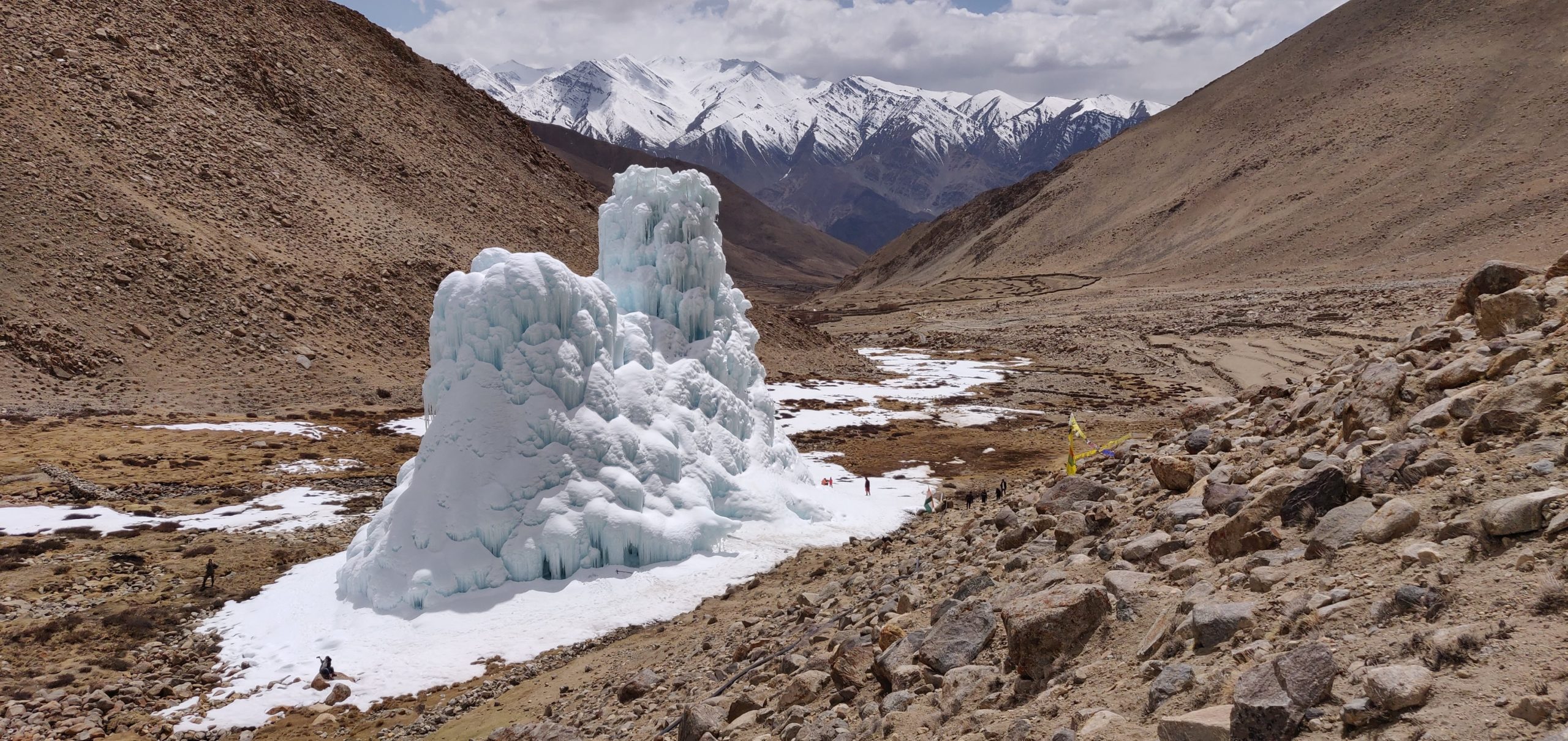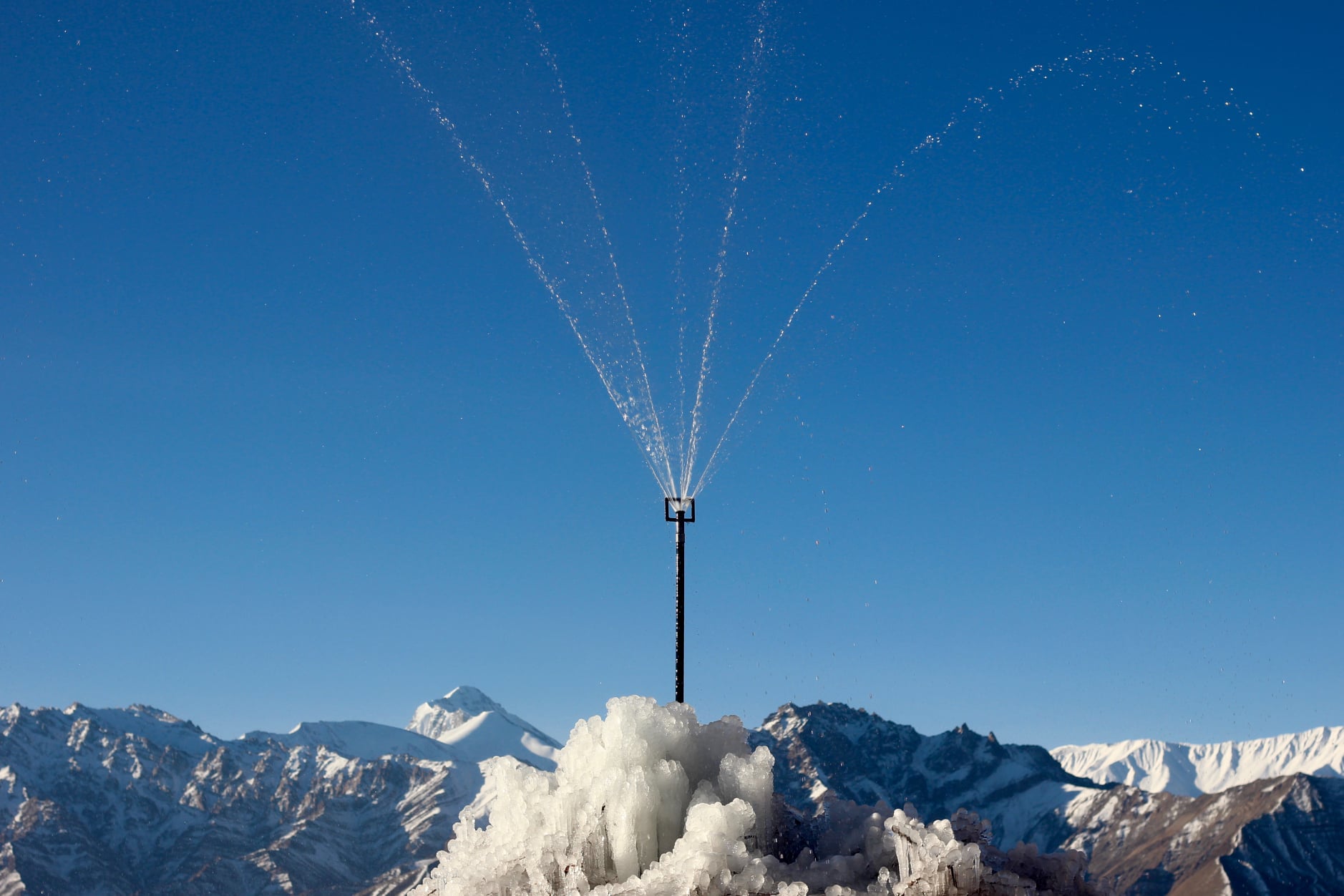
This artificial ice reservoir, or ice stupa, built by local farmers in Ladakh, India in 2019, is 30 meters (100 feet) tall and survived into early fall, releasing more than 8 million liters (2 million gallons) of meltwater.
Credit: Suryanarayanan Balasubramanian
"In Ladakh right now, many of the ice structures have stopped being built not because the farmers chose to stop watering. It is because the weather chose to stop working," said Suryanarayanan Balasubramanian, a glaciologist at the University of Fribourg in Switzerland.
The best solution is to drain the pipe before it freezes. The new automated approach avoided blocked pipes, using models and weather data to predict the optimal water spray time, duration and flow rate to build ice stupas efficiently, information the researchers said could also be applied manually.
Many ice stupas have melted by summer, but larger, more efficiently shaped ice towers can last into the following year, potentially becoming permanent structures that can provide a predictable water source year-round.
Balasubramanian will speak about the new results during a 7:00 p.m. EDT (UTC-4 hours) live-streamed discussion session.
"The point of the experiment was to show that a better methodology exists to construct these structures and there are simple lessons that we can extract. Why is that important? It shows that these structures are limited in their potential right now. They can grow much bigger and last much longer and use much less water," Balasubramanian said.
Cold storage
Ice stupas are made by fountaining water into the air during the winter to fall and freeze into giant, icy stalagmites. The pipes and fountains needed to make these great ice cones are relatively inexpensive and easily obtained, which means farmers can implement them without outside aid. Large stupas can be built from a flow rate of just 30 liters per minute, or 2-3 times the flow of a typical garden hose, if applied consistently over months, Balasubramanian said.

A fountain sprays water for an artificial ice reservoir in Ladakh, India. Low, steady flow over months can build ice towers 30 meters high. Meltwater from these structures irrigates crops in spring.
Credit: Suryanarayanan Balasubramanian
The method, first developed in Ladakh, India, has been adopted in dry, high-altitude locations in Chile and Kyrgyzstan. Ladakh sits higher than 3,000 meters (9,800 feet) above sea level between the Karakorum range and the Himalaya and receives less than 10 centimeters (4 inches) of rain or snow each year. Irrigation networks in this arid region depend on timely meltwater from glaciers, snow and permafrost, which are increasingly unreliable in a changing climate.
Spraying less, spraying smarter
Balasubramanian and colleagues tested an automated system that controlled how much water was sprayed, when and for how long, based on models and weather data. Preliminary results from drone measurements found the automated system dispensed 13% of the amount of water used by the manual fountain system to create ice stupas that delivered the same or more meltwater. The automated systems also did not require winter maintenance.
Although the automated system is currently outside the budgets of most farmers using ice stupas, Balasubramanian said development and mass production could bring down the price and make the system easier to use. Lessons learned from the automation experiments about how to optimize the duration of spray and rate of water flow based on historical freezing rates in the locality could be applied by hand.
"We have just scratched the surface on these structures, because we only talk about Ladakh. But this is not just about this one location. It could be applied many places, some of which are much, much colder. We don't know really what the upper size limit is," Balasubramanian said.
AGU (www.agu.org) supports 125,000 enthusiasts to experts worldwide in Earth and space sciences. Through broad and inclusive partnerships, we advance discovery and solution science that accelerate knowledge and create solutions that are ethical, unbiased and respectful of communities and their values. Our programs include serving as a scholarly publisher, convening virtual and in-person events and providing career support. We live our values in everything we do, such as our net zero energy renovated building in Washington, D.C. and our Ethics and Equity Center, which fosters a diverse and inclusive geoscience community to ensure responsible conduct.
Notes for journalists
Suryanarayanan Balasubramanian will present "439-02 – The surprising weather conditions favoring artificial ice reservoirs (Icestupas)" in an online discussion session on "Bridging Resolutions: Co-Developing a Practical Guide for Integrating Equity, Justice, and Place-Based Nuances for Water Scientists, Social Scientists, and Everyone In-Between" on Thursday, 23 June, at 7:00 p.m. Atlantic Standard Time (UTC-4 hours). Its focus is water solutions for remote, often Indigenous, communities that can be implemented and controlled by the local community.
This session will be live streamed for registered attendees. Press registration is open.
AGU and CUAHSI are hosting the first biennial Frontiers in Hydrology meeting (#FIHM22) in San Juan, Puerto Rico and online, 19 - 24 June 2022.
- Media registration and eligibility
- Online and on-site press information
- Presentation abstracts and schedule
Live-streamed and recorded content
Registered media can stream plenaries, online-only oral sessions and hybrid sessions live in the meeting platform. Hybrid sessions will include presenters in person in San Juan as well as online participants. Traditional in-person-only oral sessions will be recorded and available to view in the online meeting platform within a week of the events. Live-streamed presentations will also be recorded and available for later viewing. Remote attendees have access to an online poster gallery.






